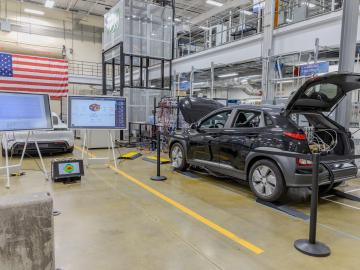
Filter News
Area of Research
News Type
News Topics
- (-) Artificial Intelligence (12)
- (-) Computer Science (26)
- (-) Energy Storage (10)
- (-) Microscopy (7)
- (-) Quantum Science (5)
- (-) Security (5)
- (-) Transportation (16)
- 3-D Printing/Advanced Manufacturing (16)
- Advanced Reactors (7)
- Big Data (14)
- Bioenergy (5)
- Biology (8)
- Biomedical (6)
- Biotechnology (2)
- Buildings (7)
- Chemical Sciences (7)
- Clean Water (9)
- Composites (5)
- Critical Materials (3)
- Cybersecurity (2)
- Emergency (1)
- Environment (24)
- Exascale Computing (1)
- Fossil Energy (1)
- Frontier (1)
- Fusion (7)
- Grid (7)
- High-Performance Computing (5)
- Isotopes (5)
- ITER (1)
- Machine Learning (12)
- Materials (5)
- Materials Science (24)
- Mathematics (4)
- Mercury (2)
- Molten Salt (4)
- Nanotechnology (9)
- National Security (4)
- Neutron Science (15)
- Nuclear Energy (21)
- Partnerships (1)
- Physics (8)
- Polymers (7)
- Simulation (6)
- Space Exploration (4)
- Summit (3)
Media Contacts

Debjani Singh, a senior scientist at ORNL, leads the HydroSource project, which enhances hydropower research by making water data more accessible and useful. With a background in water resources, data science, and earth science, Singh applies innovative tools like AI to advance research. Her career, shaped by her early exposure to science in India, focuses on bridging research with practical applications.

Oak Ridge National Laboratory scientists have developed a method leveraging artificial intelligence to accelerate the identification of environmentally friendly solvents for industrial carbon capture, biomass processing, rechargeable batteries and other applications.

John Lagergren, a staff scientist in Oak Ridge National Laboratory’s Plant Systems Biology group, is using his expertise in applied math and machine learning to develop neural networks to quickly analyze the vast amounts of data on plant traits amassed at ORNL’s Advanced Plant Phenotyping Laboratory.

ORNL scientists develop a sample holder that tumbles powdered photochemical materials within a neutron beamline — exposing more of the material to light for increased photo-activation and better photochemistry data capture.

Mohamad Zineddin hopes to establish an interdisciplinary center of excellence for nuclear security at ORNL, combining critical infrastructure assessment and protection, risk mitigation, leadership in nuclear security, education and training, nuclear security culture and resilience strategies and techniques.

An international team using neutrons set the first benchmark (one nanosecond) for a polymer-electrolyte and lithium-salt mixture. Findings could produce safer, more powerful lithium batteries.

Canan Karakaya, a R&D Staff member in the Chemical Process Scale-Up group at ORNL, was inspired to become a chemical engineer after she experienced a magical transformation that turned ammonia gas into ammonium nitrate, turning a liquid into white flakes gently floating through the air.

A team of researchers at ORNL demonstrated that a light-duty passenger electric vehicle can be wirelessly charged at 100-kW with 96% efficiency using polyphase electromagnetic coupling coils with rotating magnetic fields.

To capitalize on AI and researcher strengths, scientists developed a human-AI collaboration recommender system for improved experimentation performance.

Chelsea Chen, a polymer physicist at ORNL, is studying ion transport in solid electrolytes that could help electric vehicle battery charges last longer.


